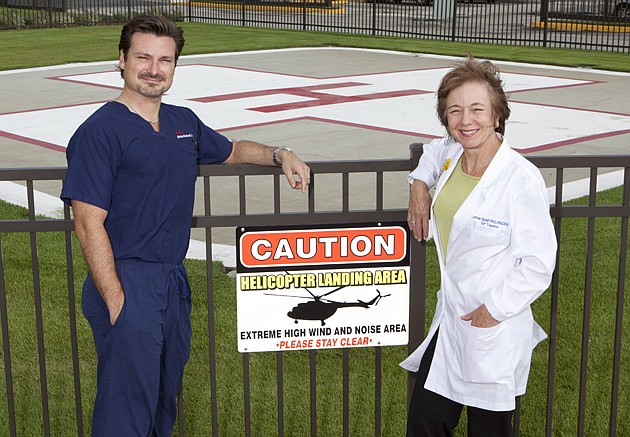- July 26, 2024
-
-
Loading

Loading

The now infamous 2,000 pages in the federal health care reform bill probably seem like a pamphlet to Dr. Brian Kimbrell and Lynne Grief.
Consider: The duo compiled at least 8,000 pages of text, documents and statements in their yearlong effort to bring the first-ever hospital trauma center to Manatee and Sarasota counties. Then they lugged the binders back and forth from Bradenton to Tallahassee for a multitude of meetings, hearings and strategy sessions.
The undertaking, at least on an interim basis, was successful. Their hospital, Blake Medical Center in west Bradenton, opened a trauma center Nov. 19 under provisional approval from state officials.
Now, after six months, Blake has begun to receive feedback on the complicated, costly and controversial move to launch the trauma center. Trauma centers, which are notoriously difficult for making profits, are basically enhanced emergency rooms, only better equipped with more staff for the most severe medical situations. Margins are thin because a department like that is expensive to operate 24 hours a day, and patients are often not covered by insurance.
Nashville-based HCA owns Blake, one of more than 40 medical centers the publicly traded firm owns in Florida. “It was a decision we made very carefully,” Blake spokeswoman Stephanie Petta says. “There was a big risk involved. But once we knew this would save lives, how could we not do it?”
The Blake trauma center treated 536 patients from DeSoto, Manatee and Sarasota counties through June 9, a figure greater than hospital officials initially projected. Of the top three injuries treated, 38% have been falls, 18% were car crashes, and 14% were motorcycle crashes, according to hospital data.
Anecdotal feedback, moreover, has been positive: Validation comes both from patients and their families, who now have a closer option in a life-and-death emergency. Also, Blake officials say there has been a halo-like effect impacting other departments since the trauma center opened. “It has raised the level of care for everyone,” says Kimbrell.
Still, considerable opposition lingers from other nearby facilities that already have trauma centers, including Bayfront Medical Center in St. Petersburg, Tampa General Hospital and St. Joseph's Hospital in Tampa. Patients seen at Blake's trauma center would have previously been treated at those hospitals, or possibly in Lee County.
That's why Bayfront, TGH and St. Joseph's attempted to block Blake and HCA's trauma expansion statewide through a lawsuit filed last year, by claiming there wasn't a community need under state law. Shands Jacksonville Medical Center joined the suit, to stop HCA from operating a trauma center in Clay County. A Tallahassee judge sided with Bayfront and the other hospitals. But the state, which approved HCA's trauma centers, appealed the ruling. The case is pending.
Big steps
While the case plays out, Blake officials and medical personnel continue to refine the trauma center. The process to open the trauma center began in September 2009, when Blake filed a letter of intent with the Florida Health Department.
Blake executives say the need was clear. For example, the trauma region where Blake operates had the fifth-highest mortality rate for traumatic brain injury in the state in 2008, according to health department data. The region also had the seventh-highest rate for falls and the eighth-highest rate for injuries related to vehicle crashes.
The next big step came in August 2010, when the hospital hired Kimbrell from a leadership position at a trauma center in Oxnard, Calif., outside Los Angeles. Grief, a registered nurse who ran the emergency room at Sarasota Memorial Hospital for six years, teamed up with Kimbrell in 2011, when Blake named her vice president of trauma services.
Kimbrell and Grief are two of about 25 employees Blake hired for the trauma center. Positions include six operating room nurses; five emergency room nurses; and four trauma surgeons. Says Grief: “It's a real challenge to take something from the ground up and build it the way you like it.”
Blake also launched a $2.5 million project to make the hospital trauma center ready. Work included building two trauma resuscitation rooms connected by a trauma command center at the existing emergency room. The hospital also built a new ramp and a second helicopter landing spot.
In addition to construction, Blake invested money in training, recruiting and setting up trauma center protocols. Plus, the hospital, in conjunction with HCA, signed a six-year agreement to share staffing and clinical expertise with Tampa-based USF Health.
Blake's provisional trauma center status could be lifted by the end of this year or early next year, hospital officials say. Petta and other hospital executives, meanwhile, remain steadfast that the trauma move was the right one. “There was a need in this community for that kind of service,” says Petta. “It made sense to pursue this.”
Defining Care
A trauma hospital offers enhanced emergency room care, in addition to access to a team of specialized medical professionals. The Florida Health Department's Office of Trauma monitors trauma centers and the regions where hospitals can operate one. The centers are broken down into Level I, Level II and pediatric trauma. Designations depend on a variety of factors, including services and personnel.